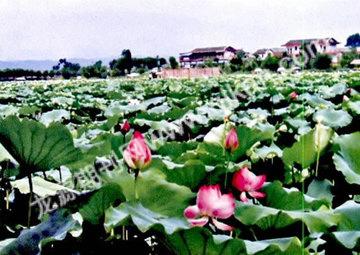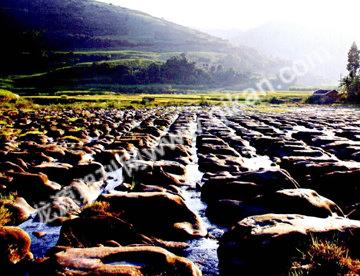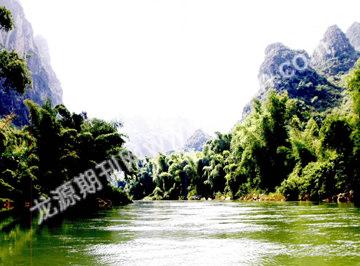A Dreamland in Southwest China
By WU MEILING

I visited Tiandong lured by a photo, a song and a poem.
The photo shows an 800,000-year-old stone axe in the shape of mango from the Paleolithic Period on the cover of the U.S. magazine Science. This discovery silenced Western voices that had argued Asia in ancient times was behind other continents in cultural progress. No such stone axes have ever been found in Europe.
The song is a Zhuang folk song I heard at a gathering of my friends. The Zhuang ethnic minority made their notch in the hall of history as early as the Three Kingdoms Period (AD 220-280). Children grow up amid the songs.
The poem is one published in Ethnic Literature magazine. One line of the poem reads: Passing through millennia-old beauty, lets meet at charming Tiandong.
Tiandong County, resembling a mango on a map, is just an hour away by car from Nanning Airport. It so happens that the county produces a lot of mangoes. As far back as the Tang Dynasty (AD 618-907) this place was an important stopover on the road to Nanning. Later, during the Southern Song Dynasty (1127-1279), this place was a famous market for the horse trade. With the passing of time, this place evolved into a town for tea and horse transactions. Today railways, highways and water transportation routes crisscross the area, providing easy access to Yunnan, Guizhou, Sichuan, Chongqing and Guangdong.
Hengshan Village
By the time we arrived at Tiandong it was already late afternoon and the evening glow had begun to appear in the sky. Before we had a chance to take the place in, Wang Xiji, the county party secretary, unraveled a series of fascinating stories of local history. For example, in AD 622, this place became an administration of county level under the name of Hengshan, a name suggesting a hill running across the local river valley plain.

In 1126, with the downfall of the Northern Song Dynasty, its last emperor fled across the Yangtze to Hangzhou, where he established the Southern Song. Due to the enemys occupation of Chinas north, the traditional Silk Road was cut. The Southern Song Empire had no means to get war supplies like horses from traditional sources in Xinjiang and Mongolia, so it had to turn to Chinas southwest. Every year, history books say, the Southern Song obtained between 1,500 and 3,500 horses from the southwest for its armies. Most of the horses came from the then Dali and Luodian areas, and were traded for tea, salt, porcelain and silk, along a road that extended to Kunming, Dali, Lijiang, Myanmar, India, and even further to places in West Asia. This road was the Silk Road in Chinas southwest.
In those years, Hengshan Village was the biggest tea/horse trading place on the road.People brought other things too, such as books. Culture from the Central Plains area radiated to remote places via this road. Thanks to these age-old cultural exchanges, Vietnam, Thailand and Myanmar still maintain similarities in their language and customs with the Zhuang ethnic group in Guangxi.

While the Southern Song and its sworn enemy the Kingdom of Jin were locked in a stalemate on the battlefield, the Mongols rose and quickly replaced the Jin as the Southern Songs number-one enemy – but they proved far more formidable. In a huge fire, Hengshan Village disappeared, leaving only remains here and there to remind later generations of its existence. These reminders are not lost, for local people today have established a historical site to boost local tourism. In July 2007, the local government made it the first “motorists camping ground” in Guangxi, an agricultural tourism demonstration spot in the following year, and a National AAA scenic area in December the same year.
Staying inside old style houses and waking up to bird twitters from trees outside the windows is a very enjoyable experience for many. This place, called Lotus World, tops the list of local eight famous landscape attractions. The moat around the ancient fortified village has a 1,000-year history, and was built by soldiers who were stationed here to guard this ancient village.
Enjoying lotuses stretching into the distance and picking lotus seeds in drifting boats are activities often found in literary pieces. Yet unless you do it personally, you wont get their full taste.
In modern history Tiandong held a special position. It has many sites of historical significance like boats, schools, and wharfs that the Red Army used. The factory that once produced uniforms for its soldiers is still here. In Baigu Red Army Village, 131 people from 85 of its 86 households joined the Red Army, and 16 died in battle. A Peoples Liberation Army general named Zhu Heyun is from this village.
Local tourism is themed around “Red Army history” and agricultural production features rice and vegetables. And of course the villagers lives are much better than before. All families have electric appliances and the majority have multi-story houses.
Chess-board Shore
This shore is indeed a blessing from Mother Nature. Forty-five kilometers from the county seat, it is located in a mountainous area north of Tiandong, right at the foot of Lotus Mount.
The shore has upper and lower parts, each pitted with row upon row of black boulders about 1-2 square meters in size, like pieces on a chessboard. Water trickles around them and converges before tumbling down a deep valley with a booming sound.
A friend asked me if I played chess. “No I dont,” I said. At this, he suggested I jump from one boulder to another. It dawned on me that I had become a pawn in someone elses game. How did this large chessboard, 210 by 150 meters, form? Some ascribe it to water flows, while others believe it came from an ancient lava flow.
Looking up, I saw the Lotus Mount, the highest peak in Tiandong. Ancient trees in it are carefully preserved, but the most unusual are the bamboo varieties. Unlike those in other places, local bamboo has triangular or square tubes, believed to be a very old species from the dinosaur age.

Close by is a gorge 50 meters long and 5-10 meters wide. With nice vegetation on either side, it makes a wonderful place for local people to have an outing.
Dragon Beard River
This river zigzagging through bamboo groves is seven kilometers from the county seat. Apart from Jiuzhaigou, an ethereal place in Sichuan, no other place has water as green as this one. Flowing between bamboo grooves gently kissed by sunshine and held affectionately by the mountains in their bosom, this river does not belong to this world, and seems like something from a dream.
Drifting down the stream in a bamboo raft, we are greeted in succession by bamboo groves, exotic flowers in luxuriant bloom, playful monkeys swinging in trees and Yao peoples wooden houses in the forest. We felt like we were in a landscape painting. It is just the beginning, we were told. The best part of the trip was between Zuodeng Street and the river mouth, a stretch about 20 kilometers long, where we saw a waterfall cascade 20 meters down two cliffs before it crashed into a huge pool below.The breath-taking view and the huge force of the waterfall left me in awe of the power of Mother Nature.
This once-in-a-life experience left me speechless. There are many attractions like this one, people said. Yet my schedule didnt allow me to prolong my stay.With regret, I bid farewell to this place, hoping to return some day to pay my respects to all of them.
According to Wei Xiaodong, the county magistrate, 350,000 tourists left Tiandong RMB 5 million richer in 2008. This year, the figure is expected to rise by a large margin. Where else can you find primitive conditions as attractive as those in Tiandong?

